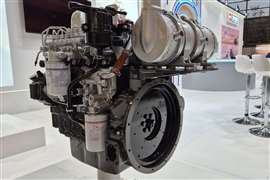Street Smarts: Bosch taking charge of EVs
28 February 2023
A few years ago, it became apparent that battery-electric vehicles (BEVs)would be a major factor in future fleet operations to meeting upcoming U.S. Environmental Protection Agency diesel emissions regulations. In the research and development rush that followed, attention was rightly focused on the vehicles themselves: Would they be able to work effectively in real-world commercial vehicle operations?

Thoughts about the infrastructure required to support commercial BEVs didn’t go much beyond finding a wall socket and remembering to plug the darn things in at night.
But as it turns out, there’s a lot more about the BEV infrastructure that needs to be considered as these vehicles near mainstream deployment in fleet operations. A lot more, in fact. The infrastructure needed to support widescale BEV use in this country, on both macro, and micro levels, has suddenly been identified as a major potential stumbling block for their initial success.
Macro vs. micro
On a macro level, many of our current electric grids nationwide (particularly in California, it should be noted) are already taxed to their limits in terms of power output. And there is serious doubt that they can handle a large, sudden, influx of power-hungry battery-electric cars, trucks and vans. And on the micro level, it turns out that refueling diesel trucks and recharging battery-electric vehicles have about as much in common as Hippies and Hell’s Angels.
 Jack Roberts is a Tuscaloosa, Ala.-based independent journalist and licensed commercial driver with more than 20 years’ experience covering the North American and global trucking industries.
Jack Roberts is a Tuscaloosa, Ala.-based independent journalist and licensed commercial driver with more than 20 years’ experience covering the North American and global trucking industries.
Many BEV-curious fleets are discovering that simply upgrading the local electric utility to handle EVs is only the beginning. Fleet facilities will need to modernize as well. Everything from the power grid at the facility to the shop floor layout will need to be reworked, while important issues like usage rates and charging times will need to be negotiated and agreed upon.
And those are just the larger issues that need to be dealt with in converting a fleet over to electric vehicles. There are a multitude of smaller issues that have to be worked, as well.
Concerns about these issues are leading many BEV OEMs and Tier I suppliers to find ways to help their customers navigate this new, unfamiliar, operational landscape. And the latest supplier to come forward is Bosch, which used CES 2023, held in Las Vegas last month, to unveil an all-new, fleet-focused, digital charging system for BEVs.
Bosch and Amazon
Bosch says its new system, developed with Amazon Web Services (AWS) essentially treats a single BEV as a node on a power grid. In other words, it’s simply one of many electric devices that needs to be optimized in order to perform to its full potential.
And that’s where Bosch’s “digital” solution to charging infrastructure comes in. The company said the system integrates into an existing system to provide the “backbone” of an information exchange system. This information system can help fleet managers with every aspect of BEV charging, Bosch said, from the utility company, to the charge point, to the maintenance shop, to the vehicle itself and all the way down to how the driver is operating it.
According to Bosch, its new Digital Charging System will help fleets with four key areas of BEV management:
- Operational optimization by providing route optimization and planning and monitoring of charging operations
- Billing and roaming with charge point booking and automated billing
- Energy market participation through utility optimization and trading energy market credits
- Smart energy management through peak shaving and energy management
Avoiding pain points
With this holistic, cloud-based, digital management service, Bosch said it can help fleets navigate many of the transitional period pain points commonly cited in a move to BEVs:
These include ensuring vehicles have sufficient daily range for planned routes on a daily basis; determining and adopting the right charging and operational strategies; tracking fleet energy consumption to ensure vehicles are always ready to go; locating available public charging stations for opportunity charging opportunities on routes and ensuring efficient vehicle use – particularly during off-peak charging hours.
Bosch said fleet managers can access all information and services provided by its Digital Charging System through a single access point in their existing portal – or, if desired, through a tailor-made customer portal or app. Additional partners, interfaces, and protocols can be easily integrated into the platform.
POWER SOURCING GUIDE
The trusted reference and buyer’s guide for 83 years
The original “desktop search engine,” guiding nearly 10,000 users in more than 90 countries it is the primary reference for specifications and details on all the components that go into engine systems.
Visit Now
STAY CONNECTED




Receive the information you need when you need it through our world-leading magazines, newsletters and daily briefings.
CONNECT WITH THE TEAM












